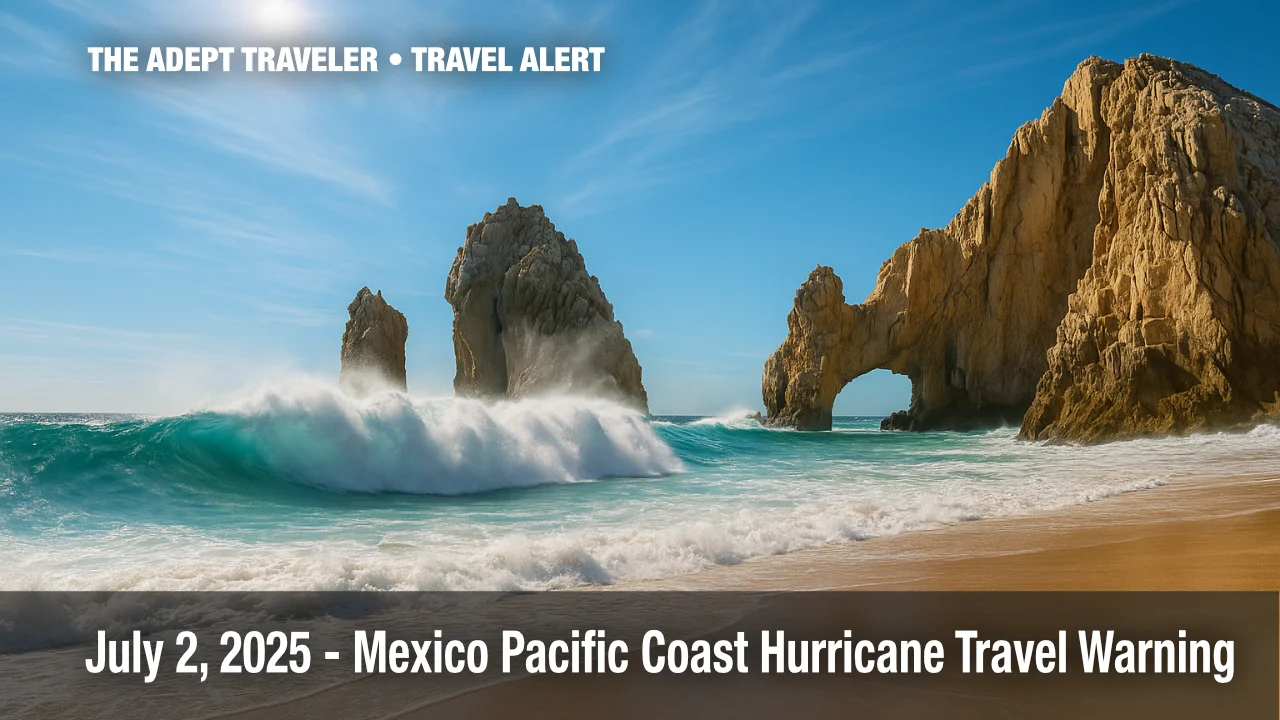A fast-strengthening Hurricane Flossie formed on Jul 1 and tracked parallel to Mexico's Pacific coast before weakening offshore on Jul 3. Although the center never made landfall, its large wind field continues to send dangerous swells toward Guerrero, Michoacán, Colima, Jalisco, and the Baja California Peninsula through at least Jul 8 2025. Officials have issued coastal warnings for life-threatening surf, rip currents, flooding rain, and mudslides. This travel warning remains in effect until seas subside.
At-a-Glance: Severity: Warning, Affected Area: Pacific coast from Guerrero to Baja California Sur, Effective: Jul 1 - Jul 8 2025
Key Points
- Impact on travelers: beaches closed, ports restricted, flights prone to delay
- Life-threatening rip currents from Zihuatanejo to Cabo San Lucas
- 2-6 inches of rain may trigger flash floods and mudslides inland
- Local civil protection urges evacuations in known slide zones
- New tropical disturbances may follow later this week
What Is Happening - Mexico Hurricane Travel Warning
Major Hurricane Flossie peaked at Category 3 strength roughly 150 miles (240 km) off Colima on Jul 2. Though now post-tropical west of Baja California Sur, the storm's broad circulation keeps pumping long-period waves toward the coast. Buoys show significant wave heights of 8 feet or more, and coastal forecasters expect sets up to 12 feet at south-facing beaches. Heavy rain bands continue to brush Michoacán, Colima, and Jalisco, where saturated slopes raise the risk of landslides blocking Highway 200 and other coastal routes. Similar rain is possible in Baja California Sur as remnants pass west-northwest.
Official Guidance
The National Hurricane Center canceled all tropical-storm watches on Jul 3 but warns that hazardous seas will persist for several days. Mexico's Servicio Meteorológico Nacional maintains a Zona de Vigilancia from Punta San Telmo (Michoacán) to Playa Pérula (Jalisco) and urges residents to obey beach closures. Protección Civil has pre-positioned shelters in Colima, Jalisco, and Baja California Sur. Ports at Manzanillo, Lázaro Cárdenas, and Puerto Vallarta may restrict small craft until wave heights fall below 8 feet. Airlines serving Los Cabos, Puerto Vallarta, and Ixtapa advise passengers to monitor flight status and allow extra time at check-in. No U.S. Department of State evacuation order is in place, but the Embassy in Mexico City recommends caution for all coastal travel.
Practical Steps
- Reconfirm flights 24 hours before departure; rebook without penalty if your carrier issues a waiver.
- Avoid swimming or surfing until local lifeguards lift red-flag warnings. Rip currents can sweep far offshore.
- If driving Highway 200, check road conditions and carry extra water and food in case of mud-slide closures.
- Secure Travel Insurance that covers trip interruption and emergency evacuation for severe weather.
- Keep Hotel staff informed of your plans and register with the U.S. Smart Traveler Enrollment Program (STEP) for alerts.
- Pack a waterproof pouch with passport, cash, and phone. Store copies of documents in the cloud.
- For updated Mexico travel safety information, visit our Global Travel Alerts hub page.
Final Thoughts
Hurricane Flossie shows that storms can endanger travelers even without landfall. Respect beach closures and monitor local advisories daily. Check long-range forecasts before booking coastal stays later in July; sea-surface temperatures remain high, favoring new storms. Travel regulations can change rapidly. Confirm requirements with official channels before departure.

